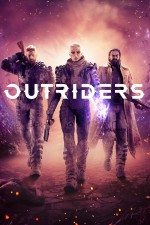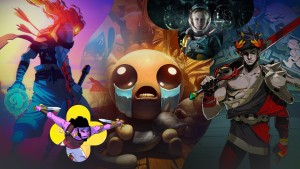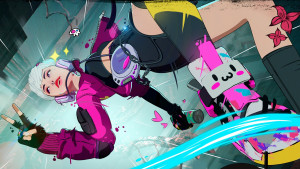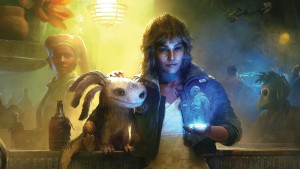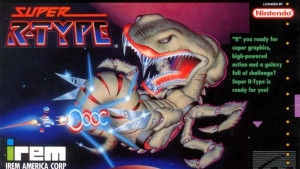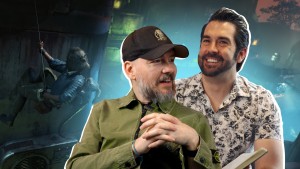Please support Game Informer. Print magazine subscriptions are less than $2 per issue

Blazing
A
New
Trail
After an amicable split from Epic Games, People Can Fly is ready to spread its wings with the all-new RPG shooter Outriders
Blazing A New Trail
Everything I've ever loved is gone.
Family. Friends. Home. It’s all back on a planet that can no longer sustain human life, a planet that we lost contact with 15 years ago. Earth is a distant memory, but there is hope: Our ship orbits Enoch, a planet that could give the 500 thousand souls on the S.S. Flores a chance at redemption. Perhaps this time we won’t fail.
The probes have given us cause for celebration: Enoch is a rare breed of “Goldilocks” planets, which is neither too hot nor too cold to sustain human life, with a breathable atmosphere and gravitational pull that won’t instantly crush us. Before we can colonize this rich new home, there’s one final formality: The Outriders have to make a quick landfall and ensure that it is, indeed, the paradise scientists have promised us all. What could possibly go wrong?

Outriders is the latest project from People Can Fly, a studio that has gone all-in with the shooter genre since it was founded in 2002. Its first game, Painkiller, was a joyous celebration of old-school shooters, and subsequent releases like Bulletstorm and Gears of War: Judgment have demonstrated that the Polish developer is willing to push the boundaries of the genre. Its latest project is easily its most ambitious undertaking so far, attempting to tell a mature story within a shooter while incorporating the RPG and loot-collecting elements that have become increasingly more prevalent across the games industry. Also, you can turn people into skeletons with your mind, if you’re into that sort of thing.
“Overall, the shooter genre is huge. We can ask ourselves why – probably people like to kill other people,” jokes game director Bartosz Kmita. “Of course, some of the elements become redundant, become repetitive, so you’re always looking for something new. You’re always looking for what you can add to the genre, what you can change.”
We visited the team in Warsaw, and it was tough not to draw some comparisons between Outriders’ narrative about charting a new course and the tumultuous events that People Can Fly has undergone over the past few years. After a planned project was canceled following THQ’s implosion in 2007, Epic Games became a majority stakeholder in the studio. There, they released Bulletstorm and Gears of War: Judgment, and worked on some other Epic projects, including tutorial content for the Unreal Engine and some work on Fortnite before its release.
“It was a bit contrary to how we see People Can Fly and how we see the future of the studio, and we didn’t want to remain an internal outsource studio,” says studio head Sebastian Wojciechowski. “We decided to chat about becoming independent, and it was great that Tim Sweeney and the other execs were supportive of this idea. In the middle of 2015, we became independent again.”
Drama vampires will have to move along for their next meal. “Even though we split with Epic, the collaboration was awesome,” Kmita says. “The experience we learned from them was great, we loved this company. But we always wanted to do our own stuff.”
In this case, “their own stuff” is Outriders. “Overall, we’ve been doing shooters for two decades, so of course this is in our DNA for what we want to do,” Kmita says. “But we were also a little bit tired of making them, so all the time we were thinking what we can do and what we can change to make the shooters that we love into something that would be enjoyable for us.”
The idea? A three-person co-op game, where players can create their own unique hero, dominating the battlefield with powerful weapons and super hero-like abilities. Customization and flexibility were key, giving players the freedom to shape their character as they see fit – whether it is selecting the type of loot they prioritize, choosing the best personal build from a variety of different powers, or geeking out over a large skill tree. All the while, it is underpinned with solid shooting mechanics that reward skill.
They shopped their idea around to various publishers, and Square Enix was enthusiastic about the team’s vision for a sci-fi shooter with RPG systems and loot. In fact, the publisher was more enthusiastic about it than People Can Fly had anticipated. “To be honest, we thought that we would grow by about twice,” Kmita says. “That was the planned version. The unplanned version was that the guys from Square would want to make this idea a little bit bigger, and little by little it grew to a lot bigger. It was two things in parallel. One was the scope of the game, which grew, and the company had to grow, too, to fulfil the needs we had for the production at that point.” The studio expanded from about 40 developers to a team of more than 200 – a decision that has necessitated an upcoming move to brand-new offices down the street.
During our visit, we had the opportunity to walk the increasingly packed offices and talk to some of the people behind Outriders. And to cap it all off, we played the game for several hours. “Gear of War meets Diablo” is a solid starting reference point for what to expect, but that oversimplification only tells a fraction of the story.
A New Beginning
We should have seen it coming. Climate change has ravaged the planet in Outriders’ lore, and with that came increased seismic activity. “Over the course of 100 years on Earth, the scientists slowly discovered that these earthquakes were going to grow worse and worse,” says lead writer Joshua Rubin. “These tremors were going to shake the world so much that cities would crumble and oceans would boil and Earth would be uninhabitable. And they had about 100 years. So of course, they told nobody.”
In 2048, a massive earthquake claimed the lives of several hundred thousand people, and it was no longer possible for the ruling class to keep their heads beneath the vibrating sands. When humanity came to terms with the reality that life on Earth was reaching its sell-by date, it experimented with a variety of plans, including cities that floated on the ever-rising seas or were buried deep underground. The more ambitious proposal saw a future among the stars. A pair of ark-like ships, the Caravel and the Flores, were crafted in orbit above Edwards Air Force base. The goal? To find a new planet where humanity could make a new home. The Outriders were an instrumental part of this interstellar evacuation.
“Originally, the outriders were supposed to be the best of humanity,” Rubin says. The Outriders are a bunch of mercs, survivors, and explorers who were recruited to be first boots on the ground on Enoch. Their mission was to secure a perimeter and prepare for the landing of the colony ship. Sounds simple, right?

Unfortunately, in what seems like an overarching theme, the plan failed in an unexpected way: The Caravel was destroyed before it could leave orbit. “Once most of them died on the first ship, there was this quick effort to improv by bringing together whoever was left,” Rubin says. “The actual Outriders who go with you on this trip are this ragtag group of mercenaries and freelancers who are not tied to any type of authority. They are doing their best to improv their way on this new planet. They have to rebuild this mythology of the Outriders.”
Before I can do my part in restoring their legacy, I must construct my Outrider. The character creator is simple, but robust. After picking my gender and one of several prebaked faces, I could swap out a variety of haircuts, alter my eye color, and select from myriad scars and makeup styles, among other options. It’s on the lighter side of customization – you won’t be fussing over eye tilt or articulating individual points on the bridge of your hero’s nose – but I was able to realize a general outline that I had in mind for my heroine using preset features: a latter-day Sarah Connor type, which fittingly, was one of the archetypical touchstones People Can Fly’s team used as inspiration for their female characters.
From orbit, Enoch does indeed seem like a promising location. Those feelings are confirmed when our landing pod detaches from the Flores in orbit and descends to the planet’s surface. From space, our pod looks tiny, but when the bay doors open it provides a greater sense of scale. It’s the size of a city block, and a small army of Outriders and military supervisors emerge – the first time any of us have been outside the ship since its 82-year voyage. Unbelievably, Enoch is everything they said it would be. It doesn’t really matter either way, since we lost contact with Earth 15 years ago, and there is no plan B.

There’s an unmistakable alien quality to the planet, but it’s remarkable just how Earth-like it appears. Even though they’re covered in glowing blue fungal colonies, the trees look like what we had back at home. And while they’re a little weird looking, there are small mammalian critters that scatter when they see us approaching, just like deer. Several huge trucks circle around what will serve as a base camp as people mill around and figure out how to best approach the mission. Before we can begin mass landings, we have to find the probes.
I run into my captain, a man named Tanner who’s wearing a cowboy hat and sunglasses. He’s marveling over the fresh air. Sensing my apprehension, he says I should look at this as a new beginning. He adds that I can build a cabin, grow old, and get fat. Whatever I do, I shouldn’t waste this opportunity. I make my way over to a makeshift shooting range, which overlays a VR-like simulation over the natural landscape. Here, I get to do something a little more engaging than walking around and talking to my fellow explorers.
The live-fire exercise gives me a chance to see how the weapons handle. As virtual enemies dart in and out of cover, I blast into them with an assault rifle and handgun. There’s a cover system, which allows my character to snap in and out with the press of a button, and transition from cover to cover by aiming at a new location and pressing the cover button. It’s pretty standard cover-shooter action, but it feels responsive and I’m able to blaze through the exercise without any problems.
Afterward, I get to talk to Jakub, my friend who’s in charge of the shooting gallery. I’m given several dialogue options, with critical conversation points marked with stars and optional choices that flesh out the world and the relationships between characters. Jakub is not as optimistic as Tanner seems to be. “He is a very cynical man,” Rubin says. “He’s someone who sees the worst in humanity at all times. He’s someone who always has something funny and awful to say about any situation.” The conversations are impressively staged. Characters move around realistically as we talk rather than stand rigidly in my face to recite dialogue. At one point, our characters sit down without interrupting the flow of their conversation. It’s a small detail that people who instinctively skip dialogue sections may not care about, but it highlights the care that People Can Fly is putting into its story and presentation.
Jakub is a bit of a downer, so I talk to Shira. She’s using a fancy transparent tablet to take pictures of the surrounding beauty. We joke that there isn’t an Internet for her to post them to, but she’s confident that the entire thing was backed up and that we’ll have access to all of humanity’s combined knowledge – and a place to send photos – within a few weeks. That is, once we locate the probe. I don’t have as much of a history with Shira as I do with Tanner and Jakub, but she seems like a positive force in our new world. “The military is there to watch over the Outriders, because the Outriders are this ragtag group of mercenaries who are not trusted by the military, and Shira is there to be the voice between them,” Rubin says.
By now, I’m getting as antsy playing as you may be reading this. Earth is dead. Got it. The new planet is cool. Understood. Is anything going to actually happen here? This is a shooter, right? Don’t worry – things ramp up significantly in just a few awful moments.

A Mysterious Signal
Engineers and workers begin dismantling our landing craft, repurposing its engine to power our budding colony. From there, the plan is to start thawing out civilians and sending them planetside, a few thousand at a time. We’ll have to pace ourselves to accommodate the new arrivals, making sure that our infrastructure can support this drain on resources. All signs point to this being a remarkably calm transition, a leap of faith that’s ended with a solid landing.
A military commander, Sergeant Major Charles Maxwell, pushes us to get going. I follow Tanner and several other Outriders as we make our way toward the probe. Trucks roll ahead, knocking down trees and creating a path for us to follow. Suddenly, our vehicles break down, as if they’ve been hit by a Hollywood-style EMP. Everything stops. We regroup, and it begins raining. Shira smiles as the droplets hit her face. Then I notice that oily black drops are mixed in. Some of it hits an Outriders’ face and mouth. He spits it out as best he can. The substance covers a tree in shimmer darkness, and Shira reaches out to touch it. We stop her before she can make contact. Droplets rise from the ground. It’s an ominous spectacle, but Tanner is fixated on the probe.
The goo has either agitated or transformed some of the local wildlife, and it attacks. It’s a strange, hulking beast, perhaps best described as a mix between a hyena and cow. It charges, and I dodge out of the way, firing at its back as it overshoots my position. After a few failed lunges, I finally knock it down for good. We get to the probe and take its hard drive. We thought the probe had been broadcasting a strange signal, but that’s not actually the case. The device was in relay mode, merely amplifying another signal that is coming from somewhere else on the planet.
Before we can ponder this impossibility, things completely fall apart. Rocks begin hovering, and we’re overwhelmed by a low-frequency rumbling sound. Orange shockwaves knock down trees, and we radio back home for help. Help isn’t coming, so we race back on foot. I run down a path as trees fall around me and energy tendrils reach out toward me. The humming sound has been replaced with explosions and screaming. It’s absolute chaos. A nearby Outrider is pulled into the air and then vaporized. In a truck, the driver who ingested some of the black substance vomits it out.
Our escape is cut off by Sgt. Maxwell and his military escort. It’s clear that we have to hold the landing until we can figure out what exactly is going on, but he says it’s too late, and that there’s nowhere else to go. Tanner attempts to argue, but Maxwell kills the Outrider commander. He walks away, telling his goons to burn the bodies. The escorts open fire on the rest of us, and we’re now engaged in a full-on shootout. I use what I learned in the earlier training exercise to move between cover, hitting the rogue soldiers with headshots while steadily moving ahead from cover to cover. One of the enemies drops a new weapon, and I equip it. I’m glad I did, because it’s a significant upgrade; every few shots fire off an explosive round that causes enemies to blast apart, causing bleed damage on nearby foes. Every successful hit does damage, which is indicated by a number that appears over the enemy’s head. Introducing RPG elements like varying damage can be tricky when implemented in shooters, where skill and accuracy are usually the most important elements. People Can Fly is keenly aware of this balancing act.

“It’s super challenging, because not only are you growing in power, but you somehow have to fulfill it,” Kmita says. “Most games are doing, ‘Ok, how to balance the gameplay? Let’s raise the health. That’s the easiest thing.’ That’s the problem that we’re talking about. Enemies become bullet sponges, or the guns start working less and aren’t doing proper damage. Overall, the balance is a huge thing for us.”
Even though I manage to survive the onslaught, I’ve seen better days. I can’t say if it’s the fight or the exposure to whatever caused gravity to flip out (not to mention that black goo), but Shira senses it, too. She hustles me over to our camp’s medical bay and puts me back into a cryo-storage chamber until a medical technician can evaluate me. In the meantime, it’s obvious that she has bigger priorities on her hands.
Starting Fresh
I awaken with a start, collapsing to the ground while heaving. How much time has passed? An alarm is going off, and a pair of scavengers seem just as surprised by our meeting as I am. One of them asks when I’m from, which is never a good sign. Before we can continue the conversation, they sprint off, saying that they’re coming for us – another comment that’s never a good sign.
A powerful-looking man clad in improvised armor strides into the scene, equally surprised to see me there. He says that he thought the Outriders were all dead. Regardless, he isn’t particularly interested in learning more. Something called the anomaly is coming, and he says that he wants to see how quickly I can run. Unfortunately, going back into the cryo chamber doesn’t appear to be an option at this time.
I’m stripped of my gear and taken to the back of a flatbed truck. The sequence is as chaotic as my first encounter with this strange phenomenon, though it’s clear that some time has passed. People appear to have settled into Enoch, though not in a “Home sweet home” needlepoint kind of way. Bodies swing from trees, and I see a hulking figure equipped with a flamethrower torching piles of corpses. Prisoners cower in dog pens. In the background, I hear chatter about this group wanting to storm the ECA base. Whatever this is, it isn’t a place I want to linger.
Then I see the anomaly. It looks like the shrinking circle in a battle-royale game, a swirling, shimmering energy field that clearly has the attention of everyone nearby. I break my cuffs and run for it, doing my best to outpace the encroaching phenomenon – an attempt that’s cut short as a length of rebar impales me straight in the center of my chest. This feels a lot like an ending, but my trip in Outriders is finally beginning.

There’s a lot going on in Outriders, and it draws from so many inspirations that it’s a little daunting to sort through it all. In case you couldn’t tell, the story is a big part of it. Rubin, the lead writer, is an experienced narrative designer who co-wrote Assassin’s Creed II, and has credits including The Walking Dead and Destiny. From the outset of the project, the team wanted to give players a compelling reason to keep moving ahead, in addition to the naturally appealing looter-shooter gameplay.
There are two main mysteries that propel players forward in Outriders’ first few hours. First, there’s the signal. The player character has been out of action for several decades, as it turns out, and humanity has indeed settled into Enoch. That colonization has been brutal, thanks to the second hook: the anomaly. The force has crippled technology, creating an environment where inhabitants have had to dig into a valley and battle over dwindling resources. All the while, the signal beckons.
“They’ve never been able to get out of the valley to find out what it is, and you’re the only person who scrawled the frequency on your hand with a Sharpie that’s still there 30 years later that can actually go and find it,” Rubin says. “All we know is that the anomaly has completely destroyed any type of electronics more complicated than a light bulb. There should not be a digital signal playing from anywhere on this planet. The fact that there is means there might be a place beyond the anomaly, and if you can reach that maybe there’s a way humanity can begin again.”
The anomaly did more than conk out electronics. People who have been exposed to its power face myriad fates. ”When you wake up 30 years later, it’s not just the world that’s changed,” Josh says. “The anomaly has pushed the flora and the fauna and changed their DNA and made them more aggressive. But you and your fellow Outriders have also been changed. It’s because of this power that has been infused into you, it’s very unpredictable, this power, it changes physics upside-down, so most people it rips apart. Some come back with almost the power of gods. The Altered are worshiped as gods by the people who live there, they’re respected and they’re feared.”
Fortunately, I’m among those who survived my brush with this uncanny force. I’m now taken to a class-selection screen, where I’m able to choose from one of four available classes. During my visit I get to play three of them – Trickster, Pyromancer, and Devastator (see sidebars) – but the fourth is tantalizingly out of reach. I start out with a Devastator, joining Game Informer video producer Leo Vader’s Trickster character for some co-op action.
A Changing Battlefield
Initially, Outriders played like a fairly standard cover shooter. All the bells and whistles were there – running over cover, blind firing, and all that jazz – but it didn’t seem as though it was doing anything really different. That sentiment is completely gone after choosing a class. Once you’re able to wield the power of the anomaly, it shifts from feeling like a straight-up shooter to one that leans heavily on action-RPG elements. We’ve played similar hybrids, including entries in the Destiny and Borderlands series, but Outriders’ comparatively shorter cooldowns lets you put your abilities to use more often. They’re not something you hoard like an ultimate in Overwatch, but another tool in your arsenal that you wield with regularity.
Alone, I’m a powerful force. I can rush up to enemy groups and harden my skin, passively absorbing their lifeforce as I blast them apart with a shotgun. When a guy unloads a chaingun at me, I turn to him and stop his volley of bullets a few feet from my face. Then I hurl it back to him with devastating effects. It feels great, and when things get a little out of control I can retreat back to cover and wait a few seconds for my abilities to recharge.
It’s even better with a friend, though. Leo’s Trickster drops time-slowing bubbles around the battlefield, giving me ample opportunity to take affected enemies out. All the while, he blips around the arena, warping behind enemies for melee attacks and darting back to sniper range to finish off any stragglers.
Popping open the skill tree, I’m surprised to see how robust it appears to be. There are three trees for each of the characters, which prioritize different elements according to a player’s style. Smaller orbs provide stat bumps, while larger nodes change the gameplay in potentially significant ways. For instance, you can bump your shotgun damage by 12 percent along the way to unlocking the Shotgun Master node, which not only increases the damage that weapon outputs by 20 percent but also increases the drop rate for shotguns. Another skill, Unbroken Vow, gives Devastators a 100-percent chance to ignore death damage and heal players for 50 percent of their maximum health automatically every three minutes.
“We’re trying to build a comp for the skills not only for yourself, but with the other people that you’re playing with to somehow complement them to make it where everyone has a role,” Kmita says. “But, it’s super important for me, we’re not forcing people to play like there is a guy who is a support, or there is a tank and there is a healer. We don’t want this. If people want to play the three DPS guys, go. If you want to play three distance guys, you can. Some strategies will be better, some will be not so cool, but we’re not forcing anyone from a gameplay perspective that you have to play this way.”
Because Outriders’ multiplayer is a co-op only experience, the team has been able to prioritize the power fantasy. “Here, we can say this would be OP in a competitive PvP environment, but let’s just go with it because it’s fun and looks amazing and we can just go all the way with it,” says game designer Łukasz Osiński. “I think this is one of the best parts of Outriders, is that you can enjoy it with your friends and everyone is going to have the feeling that their class is the most powerful. Why not. Go ahead.”
We certainly felt powerful during our demo, but that doesn’t mean it’s easy. As you play and perform well, the world level increases in the background. The higher that level, the more difficult it becomes – and the better odds that high-end loot will drop from enemies. We battled a boss named Reiner (no relation), who is partially infused with anomalous powers, and while he was a challenge he didn’t blow our minds. The team then increased the world level, and it was a significantly different experience.

Reiner’s fire tornadoes do a ton of lingering damage, and it becomes more important to interrupt him during a healing phase, lest he regenerate what little health we are able to chip at. He also has a nasty habit of calling his friends to the yard. At first, we do the normal thing and destroy them as soon as they come into frame. After a few failed attempts, it’s clear that we need to look at them as a potential health resource, albeit health resources that wield automatic weapons. Every class has its own healing mechanics that are tied to their general archetypes. My Devastator regenerates health when she’s near enemies; when we wiped the goons out as soon as they appeared, I was missing out on a way to stay alive, as counterintuitive as it may sound. Eventually, we’re able to manage both the boss and his minions effectively, and it ends with Reiner collapsing onto the ground – and dropping some pretty nice gear, to boot.
I ask Kmita about the encounter later, and he makes it clear that while we may have stumbled on something that works we won’t be able to lean on that approach every time. “It’s very tricky, because that strategy will work with that particular boss. But when you encounter the next boss, maybe that strategy will not work because the boss will buff the minions so you’ll have to start working differently. Or the longer the fight goes, the minions will become more and more powerful. So you have to always adjust your strategy to the situation which is going on in the battlefield.”
Weird Weapons
One of the many things that stands out about Outriders is that it’s a sci-fi game perfumed with the smell of gunpowder. “Because the anomaly destroyed all the electronics and all the science-fiction elements from our world, we had to go with the kinetic, more realistic weapons,” Kmita says. That self-imposed limitation means that players will have access to an arsenal based on 20th century firepower. You’ll pick up guns with different status effects and stats (remember that explosive rifle during that initial landing?), but you aren’t going to fire off any pew-pew laser blasters or anything like that.
“We didn’t want to have laser weapons,” says technical art director Krzysztof Dolas. “I don’t know why they don’t go well with us. We wanted to have this physical, kinetic power with the recoil clips. We wanted to have this feeling with the gunplay like you have this heavy weapon. Without this advanced technology, we wanted the weapons to be more interesting.”
They’re interesting all right. Thanks to the anomaly, some of the armor and higher-end guns begin to get reshaped into something strange. We couldn’t get a read on what, exactly the anomaly is, but it has a nasty habit of twisting seemingly disparate elements together. Say a weapon is near a tree when it’s hit – there’s a good chance that it will become a fused hybrid of plant and rifle. It’s still unmistakably a rifle, just one with vines and leaves woven within its form. Or one might look like something you’d craft in Monster Hunter, a bony tool of death with a jawbone near its barrel. Those are far from the strangest one we heard about during our visit.
“There’s this gun that’s covered with meat,” says audio lead Marcin Czartyński. “We figured out that while you shoot, you can have a bacon-frying sound because when you shoot that gun it overheats and the meat that is all over the place starts to boil and fry.” When it’s not cooking, it apparently pulses as though it’s alive.

The weapons can be strange, but the team is striving for a grounded feeling, as strange as that may seem. That extends to a unified look for gear. You can equip up to five different pieces of armor (helmet, chest, gloves, pants, and boots), but you won’t look like you’re going to be booking a trip to Clown Town if you can’t scrounge up a complete set of matching gear. “We don’t want to have it so when you put all the elements that don’t fit together you look like a Christmas tree,” says art director Bartosz Bieluszko. “We have a lot of variety in these grounded elements, so they fit together even when you mess them up.”
We weren’t able to see any of it in action, but players will be able to craft and upgrade their items as they play, pulling desirable mods from weapons and putting them into others. “In most games, when you think about modifications you have to find some legendary items,” Kmita says. “Of course we have legendary and super-rare items, but we have weapons with mods very early because we want this to be part of your core experience.”

New Horizons With Some Old Friends
Our demo is centered around Rift Town, which is one of the few settlements on Enoch. It’s led, coincidentally enough, by a woman named Shira. She may have saved us 30 years ago, but she isn’t particularly interested in a reunion. As the only remaining ECA officer, she’s in charge of what’s left of the failed colony. “She’s transformed from this warm, bright-eyed optimistic young scientist and is now this bitter, cold, terrified leader of these people who is doing everything she can to protect, and is failing,” Rubin says. “This is not a war that is going well, this is a war that they’re about to lose.”
She’s been working with a man – or, perhaps more accurately, a being – named Seth, but the fate of her people isn’t his priority. “Seth is an altered, like you, but he’s clearly been doing it a lot longer. You can see that being altered pushes you past any sense of being human. The things that you can do, the way that you are worshipped by the soldiers and treated like a god on the battlefield, it’s clear that this guy Seth is not driven to fight for any one side. He’s got his own mission. He’s got his own vision, that’s up above the petty concerns of humanity.” Seth also has a sense that there’s something special about you. “He’s someone who sees in you someone who has the potential for a mission to lead these people like a shepherd to a new home. Someplace new like the Outriders were supposed to do. He’s very much someone who is terrifying at first but becomes a real mentor and a guide.”
Rift Town’s days are numbered. As one of the last Outriders, it’s up to you to find a new hope for humanity – or at the very least, determine what is going on with that signal. That means leading a crew of people willing to risk their lives and see what’s beyond the valley. You’ll embark on that journey with your truck, as part of a convoy of NPCs you meet along the way, and your fellow players.
“The truck is our personal space, and it will travel through the map,” Kmita says. “You can’t drive it – you’re the boss here, so you have your own driver – but this is your home so you can customize it, you can upgrade this truck, you can use some tools in this truck like the crafting or the chest where you can store your equipment.”

You’ll also be able to show off your exploits with trophies and other decorations earned during battle. “It’s a small nod to how I experienced this when I was playing Diablo II, when someone would join in your game and you’d see his stuff, and you’d say, ‘Oh f---, how did you manage to get this?” Dolas says. “You could show off how dedicated you were to the game. We wanted to incorporate something like that in your outfit or your truck and show off that you’re into it.”
Kmita jumps in to make it clear that this isn’t going to be a place for monetization, either. “We don’t want to incorporate any pay-to-win elements or a shop where you can buy everything even if you’re not playing the game. That’s what’s crucial for us. If you have some specific armor or a thing to show off, you earned it.”
People Can Fly’s earlier games had an over-the-top flair, but Outriders reflects the fact that many members of the team have been making games together for more than 15 years. “We were more crazy – I don’t want to use the word childish – but here we tried to be a little less crazy,” Kmita says. “Of course, you can’t escape from yourself, so … [laughs] But we’re older, and we’re trying to capture maybe more of a mature tone.” There are moments of levity, to be sure, but you’re not going to be kicking people into cactuses and finishing them off with groin shots.
That doesn’t mean that they’re not having a lot of fun building Outriders. During our visit, it’s tough not to get caught up in the excitement that the team is feeling over their work. They’re effusive about the games that they’ve played in the past, which have clearly served as beacons for how (and how not to) incorporate loot and RPG elements into their game in a meaningful way. And they’re also eager to share what they’ve made with the rest of the world – and with themselves.
“We’re missing this game,” Dolas says, simply. “I would want to play this, which is why I want to make it.”
This article appears in issue 323 of Game Informer.

